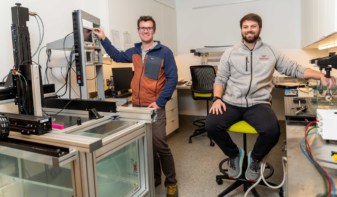
Photothermal therapy – a cancer treatment based on laser irradiation of injected gold nanorods – provides high tumour targeting accuracy with low toxicity. Now researchers in China have developed a new nanoplatform that completely eliminates solid liver cancer tumours in mice following a single five-minute light dose and without toxic side effects.
The treatment works by injecting gold nanorods directly into a tumour and then irritating them with near-infrared (NIR) laser light. This causes the nanorods to heat up and kill surrounding cancer cells. Photothermal therapy alone, however, can fail due to incomplete tumour ablation, particularly for larger lesions. This is mainly due to the limited penetration depth of light into tissue and the nanorods not fully permeating throughout the tumour.
To address these issues, the researchers deposited clusters of palladium (Pd) on the ends of gold (Au) nanorods to create heterogeneous Pd–Au nanorods. To improve biocompatibility, they modified the nanorod surfaces with bovine serum albumin (BSA). The introduction of Pd nanoclusters improves the photothermal therapy in three unique ways.
Firstly, the BSA–Pd–Au nanorods absorb light at longer wavelengths than standard gold nanorods, extending the maximum absorption wavelength from 950 to 1050 nm. In this NIR-II region, light penetrates deeper into tissue and can be used at higher maximum skin exposures.
Secondly, the nanorods can be used to activate Pro-5-Fu, a prodrug of the chemotherapy drug 5-fluorouracil (5-Fu). By injecting Pro-5-Fu intraperitoneally, then synthesizing 5-Fu in situ at the site of the BSA-Pd-Au nanorods, the potential for damaging healthy cells is minimized. Finally, the nanorods convert hydrogen peroxide into harmful reactive oxygen species. This so-called chemodynamic therapy (CDT) helps eliminate any residual tumour cells.
“Tumour eradication has been the dream of cancer patients and researchers for many years. It is of great importance to eliminate recurrence and metastasis of cancer elsewhere in the body,” says Ya Ding from China Pharmaceutical University. “However, due to the complexity, diversity and heterogeneity of tumours, a single therapy is unlikely to completely eradicate the tumour. That’s why we aimed to design a simple material or system to synergistically treat and eradicate tumours.”
In vivo testing
To evaluate the therapeutic potential of the new nanorods, Ding and collaborators (also from Peking University) examined 30 tumour-bearing mice. They divided the animals into six groups, for treatment with: saline; Pro-5-Fu; 5-Fu; BSA-Pd-Au nanorods plus Pro-5-Fu; nanorods plus laser light; and nanorods plus Pro-5-Fu plus laser light. The prodrug was delivered intraperitoneally and the nanorods injected into the tumour 1 h later.
The team used thermal imaging to assess the photothermal performance of the BSA-Pd-Au nanorods. In tumours injected with the nanorods, 1064 nm irradiation at 1 W/cm2 increased the temperature at tumour sites to 55.4±2.9 °C within 5 min. In mice treated with saline, irradiation only increased temperatures by around 7 °C.
Next, the researchers examined the efficacy of the six treatment regimes. Compared with saline, the inactivated Pro-5-Fu showed negligible therapeutic efficacy; active 5-Fu showed slightly better therapeutic efficacy than its prodrug. Both of the dual treatments – nanorods plus Pro-5-Fu, and nanorods plus laser light – displayed moderate antitumour effects with higher tumour inhibition abilities than 5-Fu alone.
The most striking antitumour effect, however, was seen in animals treated with nanorods, Pro-5-Fu and laser light. Following a single 5 min irradiation, tumours in all mice in this group were completely eradicated from the 10th day, with zero recurrence until day 24. This treatment also conferred the highest biosafety, with animals exhibiting steadily rising body weights and prolonged survival time. All mice had no perceivable side effects and all lived at least 30 days post-treatment, a milestone marker in animal model cancer research, according to the investigators.
“For the first time, we made slight and reasonable structural changes to the nanorods, comprehensively improving the nanomaterials’ ability to navigate complex disease. The result is a novel therapeutic agent that can effectively treat tumours,” says Ding.
The team describe the nanoplatform in Nano Research.



